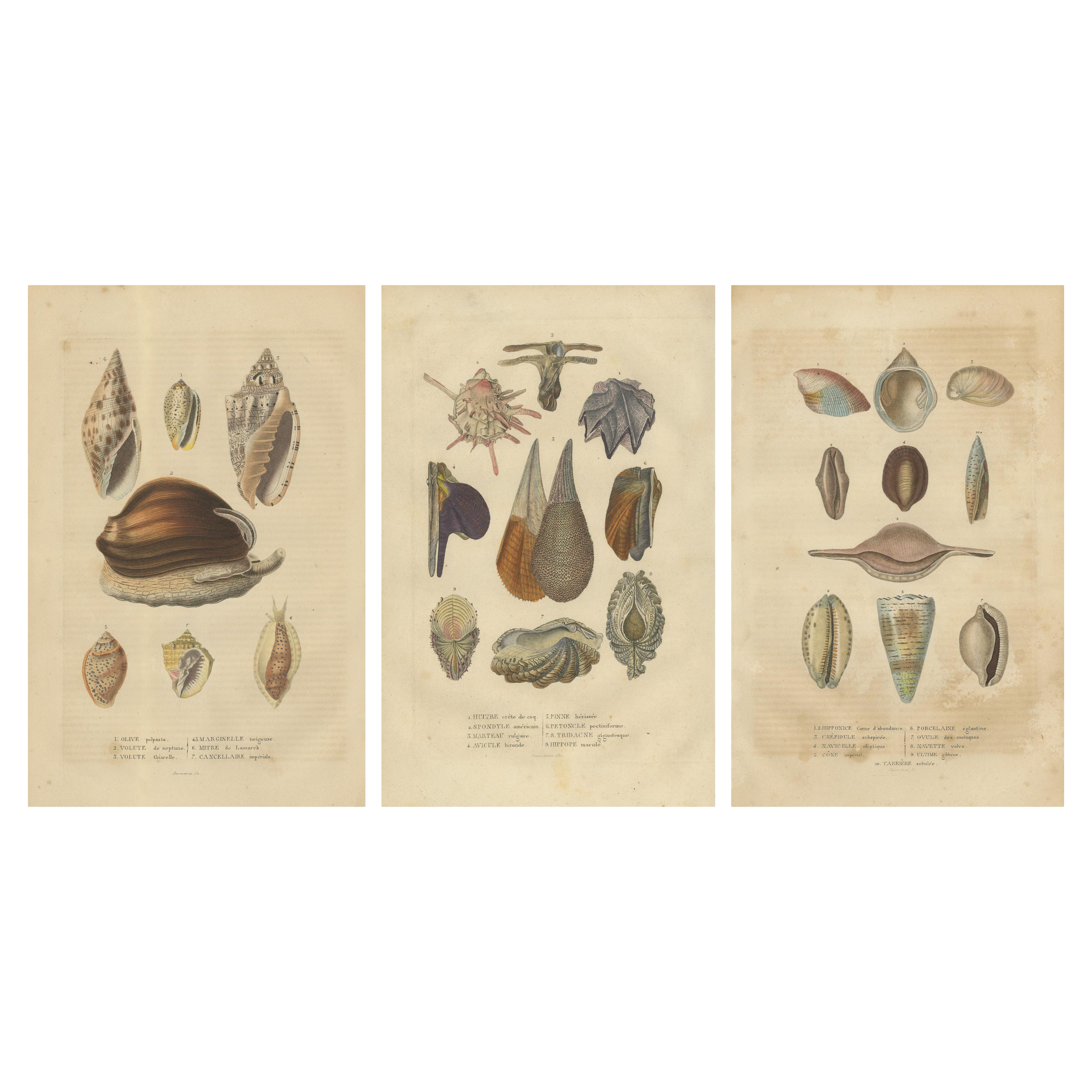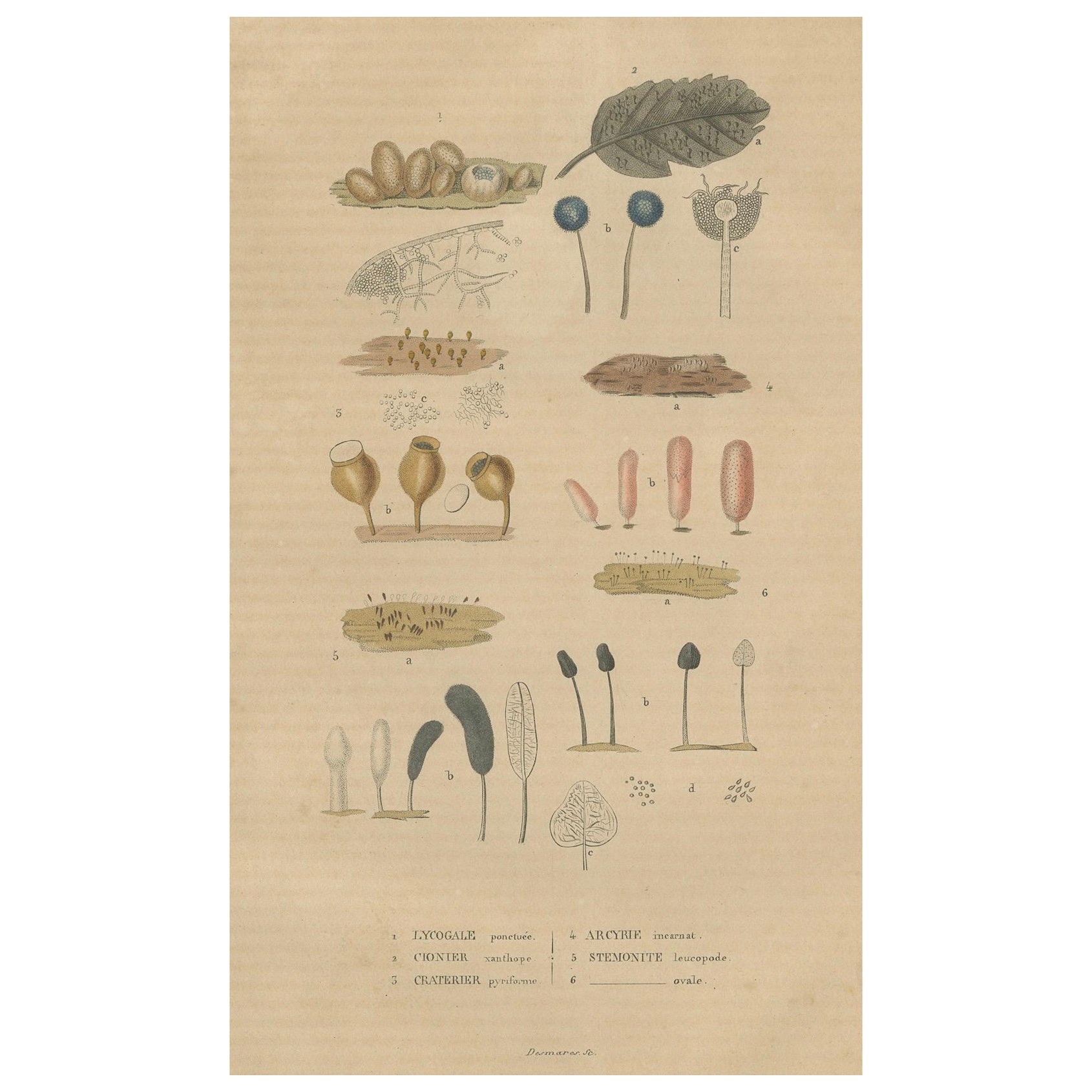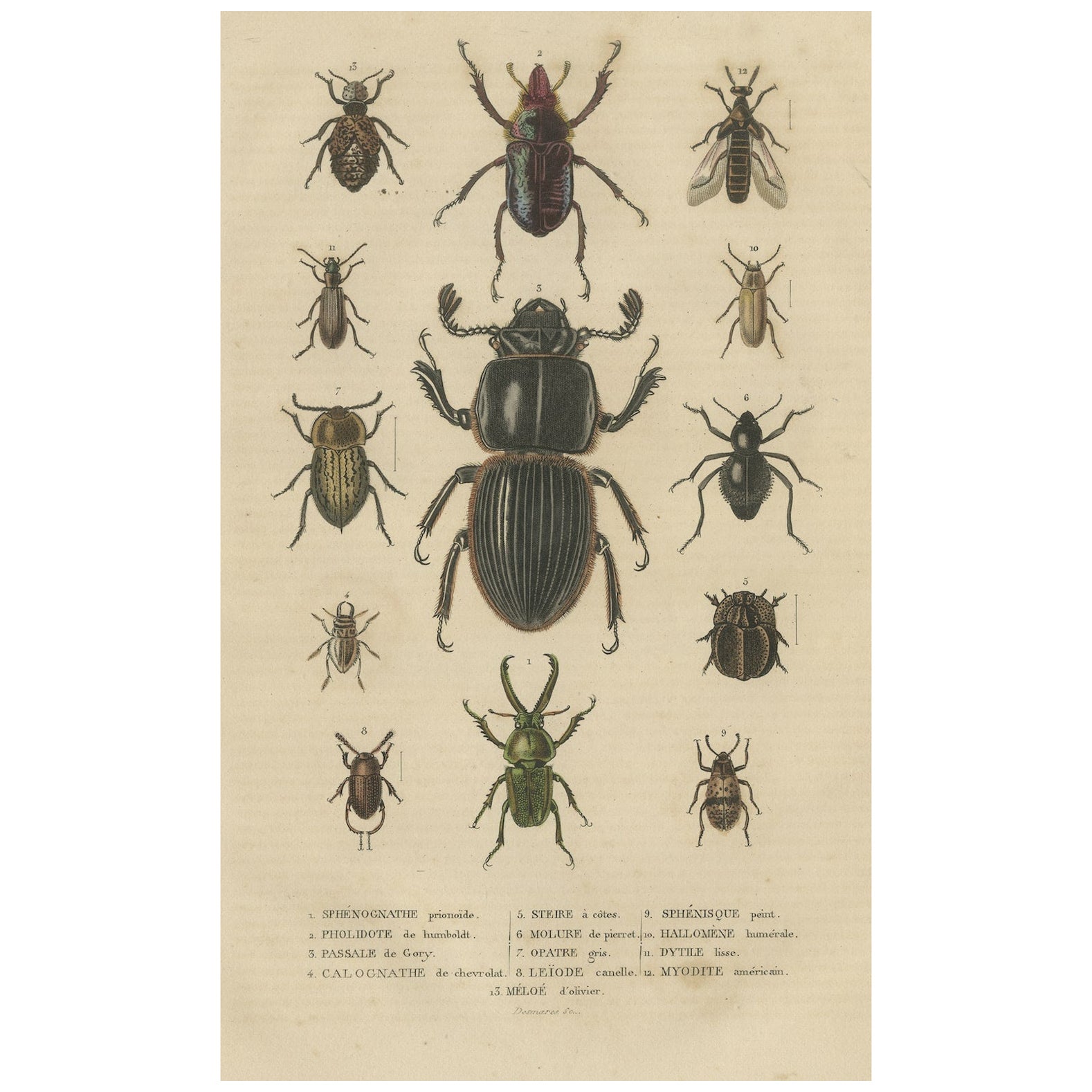Items Similar to 1845 Entomological Treasury: A Detailed Study of Insect Diversity
Want more images or videos?
Request additional images or videos from the seller
1 of 7
1845 Entomological Treasury: A Detailed Study of Insect Diversity
About the Item
A set of four antique engravings from the year 1845, depicting various insects in a detailed and hand-colored manner. These illustrations are from a scientific publication or a natural history book of that period, where such detailed engravings were common for the study and documentation of biodiversity.
Each image presents a series of different insects, labeled with numbers and sometimes names, which indicate their species or common names in French. The illustrations include various stages of the insects' life cycles and may also show anatomical details or characteristics unique to each species. The colors appear to be applied by hand, which was a common practice before the advent of color printing. The precision of these engravings suggests they were done by a skilled artist, often with a background in both art and natural sciences, to accurately portray the subjects for scientific and educational purposes.
The paper shows signs of aging, with a yellowish tint and possibly some foxing (brown spots), which adds to the authenticity of these engravings as historical artifacts. They are an excellent example of the merging of art and science in the 19th century, providing a window into the past study of entomology and the techniques used for scientific illustration at that time.
This print not only serves as a scientific record but also as a work of art, reflecting the dual interests of the Victorian era in both natural history and illustration. It is a remarkable piece that would be a significant addition to any collection of natural history art or an elegant decorative piece for those with a taste for the historic and the natural world.
The style of the illustration is reminiscent of 19th-century scientific prints, which were often used in natural history books to document various species.
More info on the book in which it was published:
The 'Dictionnaire Classique des Sciences Naturelles' by Pierre Auguste Joseph Drapiez stands as a remarkable testament to 19th-century natural sciences. Published in Brussels in 1845, this work represents an expansive collation of knowledge, building upon the pioneering works of Buffon, Daubenton, Lacepede, Cuvier, de Jussieu, and other influential naturalists.
The prints within this compendium likely showcase a rich amalgamation of artistic precision and scientific accuracy. Drapiez, himself a Belgian naturalist, would have aimed for detailed representations of flora, fauna, and scientific phenomena, mirroring the illustrative styles prevalent during his time. Given the era's emphasis on illustration, these prints were likely engraved meticulously, possibly portraying intricate anatomical details or lifelike depictions of the natural world.
With Drapiez's background in natural history, the prints might bear testament to his commitment to scientific authenticity, aiming to educate and inspire scholars and enthusiasts alike. These engravings would have complemented the text, offering visual aids that elucidate the concepts and specimens discussed in the volume.
Overall, the prints of 'Dictionnaire Classique des Sciences Naturelles' likely serve as both artistic representations and invaluable scientific resources, encapsulating the essence of 19th-century natural history exploration and documentation.
The uploaded images are detailed antique engravings of various insects, with annotations in French that identify each one. While I can describe the types of insects depicted based on their general appearance, the precise identification would typically require a clear view of the text annotations and detailed aspects of their morphology. However, I can provide a general identification based on visible characteristics:
1. **Hymenoptera Wings (Ailes d'Hyménoptères)**: This would include various species of bees, wasps, and ants. Hymenoptera is a large order of insects that includes these species, characterized by two pairs of wings, with the forewings larger than the hind wings, and a constriction between the thorax and abdomen.
2. **Coleoptera (Beetles)**: This order of insects is characterized by hard forewings and a wide variety of shapes and colors. They are the largest order of insects, with more than 350,000 described species.
3. **Various Fly Species (Diptera)**: Flies are characterized by having only one pair of wings, with the second pair reduced to small structures called halteres that are used for balance.
4. **Ladybugs and other Beetles (Coccinellidae and other Coleoptera)**: Ladybugs are known for their distinctive colors and spots. Other beetles in the same order may vary greatly in shape, size, and coloration.
These engravings were often used in the 19th century as educational tools and for scientific documentation, and the level of detail they provide was crucial for the study of entomology at the time. Each species is typically labeled with a number corresponding to a name or description, which provides more specific information about the depicted species.
- Dimensions:Height: 10.44 in (26.5 cm)Width: 6.7 in (17 cm)Depth: 0 in (0.02 mm)
- Sold As:Set of 4
- Materials and Techniques:Paper,Engraved
- Period:
- Date of Manufacture:1845
- Condition:Condition: Fair. Overal toning and some foxing. The images itself clean and hand-colored in expliciet colors. Offset from a opposite text plate in the original book. Left side rough from the cutting of the book. Please study scan carefully.
- Seller Location:Langweer, NL
- Reference Number:
About the Seller
5.0
Platinum Seller
These expertly vetted sellers are 1stDibs' most experienced sellers and are rated highest by our customers.
Established in 2009
1stDibs seller since 2017
1,960 sales on 1stDibs
Typical response time: <1 hour
- ShippingRetrieving quote...Ships From: Langweer, Netherlands
- Return PolicyA return for this item may be initiated within 14 days of delivery.
More From This SellerView All
- 1845 Handcolored Bat Engraving: A Study of Chiroptera DiversityLocated in Langweer, NLThe print is an 1845 handcolored engraving that features a selection of six different bat species, each carefully illustrated to highlight their distinctive anatomical features. Thes...Category
Antique 1840s Prints
MaterialsPaper
- Diversity in Carapace: A Study of Turtle Patterns and Colors, 1845Located in Langweer, NLThis print depicts three turtles, each with distinct patterns and colors on their shells and skin: 1. **Top Turtle**: This turtle has a relatively dark shell with light markings that emphasize the ridges of the scutes (the individual plates that make up the turtle's carapace or shell). The plastron (the belly part of the shell) appears to be lightly colored with dark seams. The skin of the turtle is striped with light and dark bands, suggesting a pattern that may help with camouflage or identification among species. 2. **Bottom Left Turtle (labeled 'a')**: This specimen has a shell with a more vibrant green color and bold, light-colored markings. The plastron is red with a symmetrical pattern, which is quite distinctive. This coloration may be characteristic of a particular species or could be an artistic interpretation to highlight anatomical details. 3. **Bottom Right Turtle (labeled 'b')**: The shell of this turtle is green with a lighter central area and dark borders on the scutes, while the plastron is a contrasting red with a white pattern. The green color extends to the skin, with lighter stripes on the limbs. The print shows illustrations of turtles, and it seems to label them as "Emys picta" and "Emyde peinte," which could refer to painted turtles...Category
Antique 1840s Prints
MaterialsPaper
- Fungal Forms: Illustrations of Mycological Diversity, 1845Located in Langweer, NLThis illustration does not depict animals, but rather a variety of fungi, which are a diverse group of organisms that include yeasts, molds, and the more familiar mushrooms. They pla...Category
Antique 1840s Prints
MaterialsPaper
- Entomological Elegance: An Original Antique Catalogue of Beetles, 1845Located in Langweer, NLAntique hand-colored print depicting various beetles. Each beetle is meticulously illustrated, likely hand-colored after printing, which was the style of the mid-19th century scientific illustrations. The image includes a key at the bottom, which provides the names of the beetles in French, such as "SPHENOQNCATHE primordie" and "PHILODTE de humboldt," among others. (see below). These illustrations were part of an entomological reference in "Dictionnaire Classique des Sciences Naturelles" by Pierre Auguste Joseph Drapiez. These beetles would have been represented to aid in the scientific study and categorization of insect species...Category
Antique 1840s Prints
MaterialsPaper
- Marine Elegance: A 19th Century Mosaic of Mollusk Diversity, 1845Located in Langweer, NLThe engravings depict a variety of marine organisms, specifically mollusks, which include both gastropods and bivalves. The details for the three prints provided are as follows: 1. ...Category
Antique 1840s Prints
MaterialsPaper
- Marine Mollusk Diversity: Sponges, Abalones, Limpets, and Chitons, 1845Located in Langweer, NLThis original antique engraving depicts a collection of marine mollusks, which are a diverse group of invertebrates living mostly in aquatic habitats. These are likely depicted for t...Category
Antique 1840s Prints
MaterialsPaper
You May Also Like
- Early XXth Century French Engraving of InsectsLocated in Barcelona, ES"Early XXth Century French Engraving of Insects" Origin: France, early XXth century Art Form: Engraving Subject: Insects Transport yourself to the fascinating world of ...Category
20th Century French Mid-Century Modern Prints
MaterialsPaper
- Studies of Ballet Etching by SorensonLocated in Savannah, GAAn etching entitled “Studies of Ballet”, signed Sorensen, artist proof. sight: 10 ½ by 13 ½ inches frame: 17 by 21 inchesCategory
Mid-20th Century Mid-Century Modern Prints
MaterialsGlass, Wood, Paper
- Butterlies, Metamorphosis of Insects, Large Folio, L'Admiral, Hand ColouredLocated in Norwich, GBAntique print, untitled. From: 'Naauwkeurige waarnemingen omtrent de veranderingen van veele insekten …' Published 1740. Overall size: 36.5 x 26.2 cm Original hand colour. ...Category
Antique 1740s Dutch Prints
MaterialsPaper
- Antique Swedish School, Teaching Chart, Poster "Insects"Located in Vienna, ATAntique wall chart depicting "insects." This is a reprint probably from the 1950s. Colorful print on paper. Good original condition, age-related t...Category
Vintage 1950s Swedish Prints
- Set of Jean Bungartz Dog Art - Head Study PrintsLocated in Houston, TXAntique, dog engravings from a portfolio of drawings by a German artist, Jean Bungartz, published in 1890. If you own one of these dogs, you will...Category
Antique Late 19th Century German Prints
MaterialsPaper
- 1750 Schaffhausen, Seutter, Large and Detailed Map SwitzerlandBy Matthew SeutterLocated in Norwich, GBSandrart Joachim, von (1606-1688) Effigies antiquae Romae. redacta a Pyrrho Ligorio Romano, per XIIII Regiones, in quas Urbem divisit Imp. Caesar August. Nuremberg, Germany, pu...Category
Antique 1670s Italian Baroque Prints
MaterialsPaper
Recently Viewed
View AllMore Ways To Browse
Print Halter
Pair Of Antique Windows
Victorian Insect
French Victorian Mirror
Antique Flies
Pairs Of Small French Mirrors
Large Belgian Wall Mirror
Bee Wall Art
Large Colored Mirror Art
Antique Ants
Pair Engraved Mirror
Victorian Fly
Treasury Building
Victorian Beetle
Victorian Bee
French Ant
Antique Tinted Mirror
Antique Ladybug





